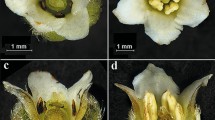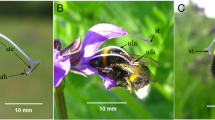Abstract
Although florivores can destroy significant amounts of sexual tissues and indirectly affect pollination, little is known about their preferences, which could shape the evolution of floral traits or defense. In this study, we used a gynodioecious plant Nemophila menziesii, and its main florivore Platyprepia virginalis, to test which floral characteristics are associated with florivory in the field and with florivore choice in the laboratory. Hermaphrodite flowers consistently received more damage than nearby females in the field. In the laboratory setting, florivores also preferred unmanipulated hermaphrodites versus unmanipulated females. Systematic evaluation of hermaphrodite traits, such as corolla size, anther presence, and corolla color, revealed that corolla diameter was the main determinant of florivore preference in this system. Here, we discuss the implications of both pollinator and florivore choice in the evolution of corolla size and sex ratio in gynodioecious species with cytoplasmic male sterility and emphasize the need for more information on the preferences of florivores.




Similar content being viewed by others
References
Arista M, Ortiz PL (2007) Differential gender selection on floral size: an experimental approach using Cistus salvifolius. J Ecol 95:973–982
Ashman TL (2002) The role of herbivores in the evolution of separate sexes from hermaphroditism. Ecology 83:1175–1184
Ashman TL, Penet L (2007) Direct and indirect effects of a sex-biased antagonist on male and female fertility: consequences for reproductive trait evolution in a gender-dimorphic plant. Am Nat 169:595–608
Ashman TL, Swetz J, Shivitz S (2000) Understanding the basis of pollinator selectivity in sexually dimorphic Fragaria virginiana. Oikos 90:347–356
Ashman TL, Cole DH, Bradburn M (2004) Sex-differential resistance and tolerance to herbivory in a gynodioecious wild strawberry. Ecology 85:2550–2559
Ashman TL, Bradburn M, Cole DH, Blaney BH, Raguso RA (2005) The scent of a male: the role of floral volatiles in pollination of a gender dimorphic plant. Ecology 86:2099–2105
Asikainen E, Mutikainen P (2005) Preferences of pollinators and herbivores in gynodioecious Geranium sylvaticum. Ann Bot 95:879–886
Bailey MF, Delph LF (2007) A field guide to models of sex-ratio evolution in gynodioecious species. Oikos 116:1609–1617
Bandeili B, Müller C (2010) Folivory versus florivory—adaptiveness of flower feeding. Naturwissenschaften 97:79–88
Barr CM (2004) Hybridization and regional sex ratios in Nemophila menziesii. J Evol Biol 17:786–794
Barr CM (2008) Spatial and temporal female frequency variation in a plant with joint nuclear and cytoplasmic sex determination. Evol Ecol Res 10:835–848
Barr CM, Fishman L (2011) Cytoplasmic male sterility in Mimulus hybrids has pleiotropic effects on corolla and pistil traits. Heredity 106:886–893
Campbell DR, Crawford N, Brody AK, Forbis TA (2002) Resistance to pre-dispersal seed predators in a natural hybrid zone. Oecologia 131:436–443
Cariveau D, Irwin RE, Brody AK, Garcia-Mayeya LS, van der Ohe A (2004) Direct and indirect effects of pollinators and seed predators to selection on plant and floral traits. Oikos 104:15–26
Carlson JE, Harms KE (2007) The benefits of bathing buds: water calyces protect flowers from a microlepidopteran herbivore. Biol Lett 3:405–407
Cornelissen T, Stiling P (2005) Sex-biased herbivory: a meta-analysis of the effects of gender on plant–herbivore interactions. Oikos 111:488–500
Cosmides LM, Tooby J (1981) Cytoplasmic inheritance and intragenomic conflict. J Theor Biol 89:83–129
Cruden RW (1972) Pollination biology of Nemophila menziesii (Hydrophyllaceae) with comments on the evolution of oligolectic bees. Evolution 26:373–389
Cunningham SA (1995) Ecological constraints on fruit initiation by Calyptrogyne ghiesbreightiana (Araceae): floral herbivory, pollen availability, and visitation by pollinating bats. Am J Bot 82:1527–1536
Delph LF, Galloway LF, Stanton ML (1996) Sexual dimorphism in flower size. Am Nat 148:299–320
Despland E, Simpson JS (2000) Small-scale vegetation patterns in the parental environment influence the phase state of hatchlings of the desert locust. Physiol Entomol 25:74–81
Eckhart VM (1992) The genetics of gender and the effects of gender on floral characters in gynodioecious Phacelia linearis (Hydrophyllaceae). Am J Bot 79:792–800
Faul F, Erdfelder E, Lang A-G, Buchner A (2007) G*Power 3: a flexible statistical power analysis program for the social, behavioral, and biomedical sciences. Behav Res Methods 39:175–191
Fineblum EL, Rausher MD (1997) Do floral pigmentation genes also influence resistance to enemies? Ecology 78:1646–1654
Frank SA (1989) The evolutionary dynamics of cytoplasmic male sterility. Am Nat 133:345–376
Frank SA, Barr CM (2002) Spatial dynamics of cytoplasmic male sterility. In: Silvertown J, Antonovics J (eds) Integrating ecology and evolution in a spatial context. Blackwell Science, Oxford, pp 219–243
Frey FM (2004) Opposing natural selection from herbivores and pathogens may maintain floral-color variation in Claytonia virginica (Portulacaceae). Evolution 58:2426–2437
Galen C, Cuba J (2001) Down the tube: pollinators, predators, and the evolution of flower shape in the alpine skypilot, Polemonium viscosum. Evolution 55:1963–1971
Ganders FR (1978) The genetics and evolution of gynodioecy in Nemophila menziesii (Hydrophyllaceae). Can J Bot 56:1400–1408
Halse RR (1993) Hydrophyllaceae: Nemophila. In: Hickman JC (ed) The Jepson manual: higher plants of California. University of California Press, Berkeley, pp 690–691
Hanley ME, Lamont BB, Armbruster WS (2009) Pollination and plant defence traits co-vary in western Australian hakeas. New Phytol 182:251–260
Hedin PA, Jenkins JN, Collum DH, White WH, Parrott WL, MacGown MW (1983) Cyanidin-3-beta-glucoside, a newly recognized basis for resistance in cotton to the tobacco budworm Heliothis virescens (Fab) (Lepidoptera: Noctuidae). Experientia 39:799–801
Hegland SJ, Totland Ø (2005) Relationships between species’ floral traits and pollinator visitation in a temperate grassland. Oecologia 145:586–594
Islam MS, Roessingh P, Simpson SJ, McAfferty AR (1994) Parental effects on the behavior and coloration of nymphs of the desert locust Schistocera gregaria. J Insect Physiol 40:173–180
Karban R, English-Loeb G (1997) Tachinid parasitoids affect host plant choice by caterpillars to increase caterpillar survival. Ecology 78:603–611
Karban R, Karban C, Huntzinger M, Pearse I, Crutsinger G (2010) Diet mixing enhances the performance of a generalist caterpillar, Platyprepia virginalis. Ecol Entomol 35:92–99
Krupnick GA, Weis AE (1999) The effect of floral herbivory on make and female reproductive success in Isomeris arborea. Ecology 80:135–139
Kudoh H, Whigham DF (1998) The effect of petal size manipulation on pollinator/seed predator mediated female reproductive success of Hibiscus moscheutos. Oecologia 117:70–79
Leege LM, Wolfe LM (2002) Do floral herbivores respond to variation in flower characteristics in Gelsemium sempervirens (Loganiaceae), a distylous vine? Am J Bot 89:1270–1274
Marshall M, Ganders FR (2001) Sex-biased seed predation and the maintenance of females in a gynodioecious plant. Am J Bot 88:1437–1443
McCall AC (2006) Natural and artificial floral damage induces resistance in Nemophila menziesii (Hydrophyllaceae) flowers. Oikos 112:660–666
McCall AC (2007) Leaf damage and gender but not flower damage affect female fitness in Nemophila menziesii (Hydrophyllaceae). Am J Bot 94:445–450
McCall AC (2008) Florivory affects pollinator visitation and female fitness in Nemophila menziesii. Oecologia 155:729–737
McCall AC (2010) Does dose-dependent petal damage affect pollen limitation in a California annual plant? Botany 88:601–606
McCall AC, Irwin RE (2006) Florivory: the intersection of pollination and herbivory. Ecol Lett 9:1351–1365
McCall AC, Karban K (2006) Induction of defense in Nicotiana attenuata flowers following leaf damage. Oecologia 146:566–571
Mothershead K, Marquis RJ (2000) Fitness impacts of herbivory through indirect effects on plant-pollinator interactions in Oenothera macrocarpa. Ecology 81:30–40
Munz PA (1959) A California flora. University of California Press, Berkeley
Penet L, Collin CL, Ashman T-L (2009) Florivory increases selfing: an experimental study in the wild strawberry, Frageria virginiana. Plant Biol 11:38–45
Rice WR (1989) Analyzing tables of statistical tests. Evolution 43:223–225
Schultz ST (2003) Sexual dimorphism in gynodioecious Sidalcea hirtipes (Malvaceae). II. Floral traits. Int J Plant Sci 164:175–180
Sletvold N, Grindeland JM (2008) Floral herbivory increases with inflorescence size and local plant density in Digitalis purpurea. Acta Oecol Int J Ecol 34:21–25
Sletvold N, Grindeland JM, Ågren J (2010) Pollinator-mediated selection on floral traits and flowering phenology in the deceptive orchid Dactylorhiza lapponica. New Phytol 188:385–392
Stanton ML, Preston RE (1988) Ecological consequences and phenotypic correlates of petal size variation in wild radish, Raphanus sativus (Brassicaceae). Am J Bot 75:528–539
Strauss SY, Armbruster WS (1997) Linking herbivory and pollination: new perspectives on plant and animal ecology and evolution. Ecology 78:1617–1618
Strauss SY, Whittall JB (2006) Non-pollinator agents of selection on floral traits. In: Harder L, Barrett S (eds) Ecology and evolution of flowers. Oxford University Press, Oxford, pp 120–138
Strauss SY, Irwin RE, Lambrix V (2004) Optimal defense theory and flower petal colour predict variation in the secondary chemistry of wild radish. J Ecol 92:132–141
Texido AL, Méndez M, Valladares F (2011) Flower size and longevity influence florivory in the large-flowered shrub Cistus ladanifer. Acta Oecol 37:418–421
Theis N, Lerdau M, Raguso RA (2007) The challenge of attracting pollinators while evading floral herbivores: patterns of fragrance emission in Cirsium arvense and Cirsium repandum (Asteraceae). Int J Plant Sci 168:587–601
Thompson JD, Rolland AG, Prugnolle F (2002) Genetic variation for sexual dimorphism in flower size within and between populations of gynodioecious Thymus vulgaris. J Evol Biol 15:362–372
Washitani I, Okayama Y, Sato K, Takahashi H, Ohgushi T (1996) Spatial variation in female fertility related to interactions with flower consumers and pathogens in a forest metapopulation of Primula sieboldii. Res Popul Ecol 38:249–256
Acknowledgments
We would like to thank Peter Connors, Claudia Luke, and Jackie Sones at the Bodega Marine Reserve for their permission and assistance throughout the long gestation of this paper. We also thank Richard Karban, Louie Yang, Thomas Schultz, and two anonymous reviewers for helpful comments on earlier versions of this work.
Author information
Authors and Affiliations
Corresponding author
Additional information
Communicated by Diethart Matthies.
Rights and permissions
About this article
Cite this article
McCall, A.C., Barr, C.M. Why do florivores prefer hermaphrodites over females in Nemophila menziesii (Boraginaceae)?. Oecologia 170, 147–157 (2012). https://doi.org/10.1007/s00442-012-2278-z
Received:
Accepted:
Published:
Issue Date:
DOI: https://doi.org/10.1007/s00442-012-2278-z




